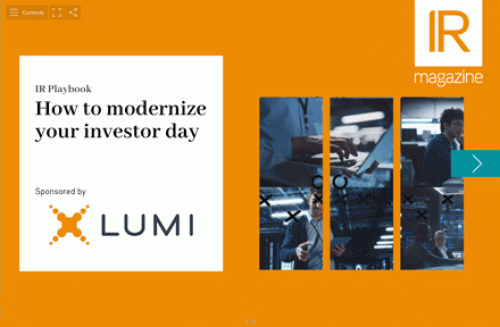While presentation meetings with potential investors are a key IR task, mastering an effective delivery can be challenging. It all depends on crystal-clear communications, proactive use of digital tools, transparency and added value.

‘Messaging is getting better and delivery is getting richer,’ said Harry Shah, founder and CEO at OUTKREATE, during a recent IR Magazine webinar now available to watch on demand, in which we asked IROs and investors to define what makes a good presentation and point out some of the regular gaffes they see.
For a company, the focus must be on answering the needs of the analysts and investors and the key to that is to keep things simple, think two steps ahead and be mindful of who you are talking to, say experts.
For Gervais Williams, head of equities at Premier Miton Investors, presentations are about understanding the long-term investment thesis and the role of the management team within a company.

Premier Miton Investors
‘It’s about the scale of the opportunity, the true cash in and cash out, which we’re very interested in,’ he said at the webinar. ‘And metrics along the way as to how progress is going. Companies often say it’s going quite well, or it’s going really well. But what we’re looking for is something a bit more demanding that actually gives us real insight: perhaps they have won a large number of customers, maybe they have got verification from some large brand names around the world.
‘We use proxies like that to get a real understanding on the detail of the business and the scale of the upside. Most particularly, cash generation and the duration before you get into that cash generation are the risks we’re willing to tolerate on behalf of our customers.
‘You need to inject a lot of thought into making sure you keep your investors entrenched because if they feel [your presentation] is really helpful and they learn things, they will see you again. If they keep seeing the same old thing, they won’t see you again.’
Keeping your message alive

Verra Mobility
Balancing time constraints with the amount of information companies need to provide to investors and analysts is also a juggling act. Focusing on actionable tips, catchy visuals and highlighting corporate next steps in the wider market ecosystem are considered best practice.
‘It’s called ‘so what?’ structure,’ Shah explained. ‘When you look at what’s going on around you and the macro trends, think about the headwinds and the tailwinds. So what? How is your company and your strategy affected by that? If those are the trends, what does it mean for you and what are your next steps?’
Showing investors that the company financial model is based on the wider market opportunities and factoring that into the presentation structure could gain IROs an edge, experts said. Steering away from past practices would also be beneficial, changing and adapting visuals to investors’ needs and avoiding cluttering or overloading slides with too much information.
Mark Zindler, vice president of IR at Verra Mobility, said it’s important ‘not to fall into the trap’ of sticking to what’s usually been done.
‘Develop key objectives,’ he advised. ‘Do not repeat what you have done before or rely too much on a template. Really assess what it is you want to convey in this presentation to that specific audience, and then you can figure it out. Use pictures because one picture is worth a thousand words.’










